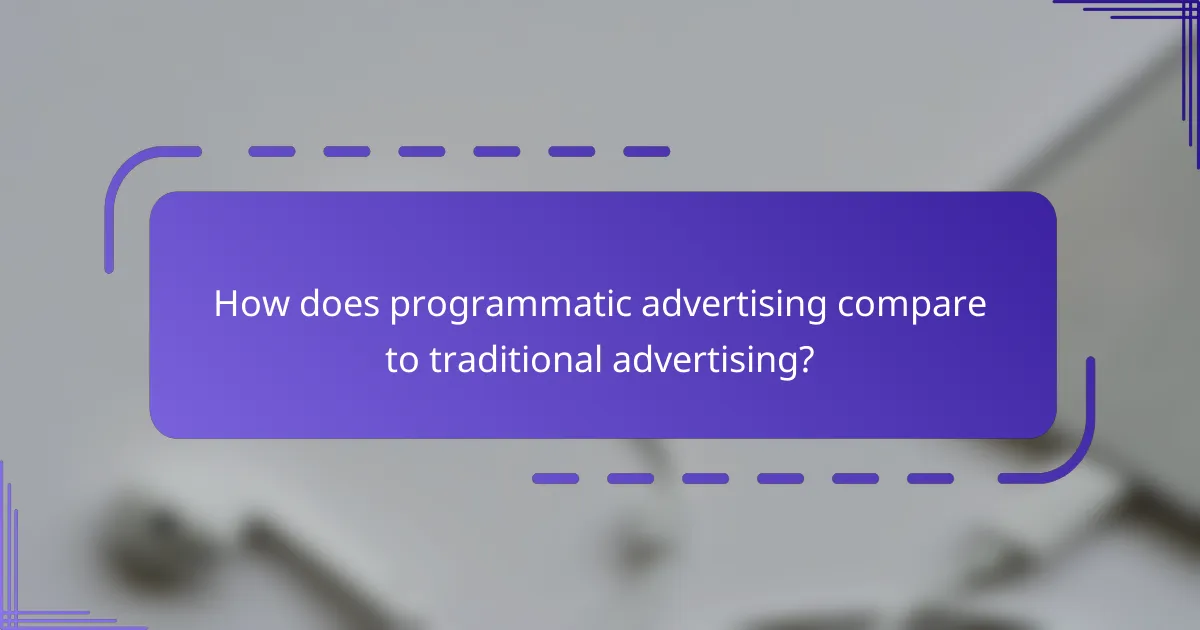Programmatic advertising is rapidly transforming the landscape of digital marketing, particularly in the UK, as brands increasingly invest in this technology. By harnessing AI and expanding digital inventory, advertisers can achieve more efficient and targeted campaigns. The benefits of programmatic advertising, such as enhanced targeting and real-time bidding, lead to improved return on investment. To maximize these advantages, effective strategies include leveraging data-driven insights and cross-channel approaches.

How is programmatic advertising growing in the UK?
Programmatic advertising in the UK is experiencing significant growth driven by increased brand investment, the integration of AI technologies, and the expansion of available digital inventory. This evolution is reshaping how advertisers reach their audiences, making campaigns more efficient and targeted.
Increased investment from brands
Brands in the UK are increasingly allocating larger portions of their advertising budgets to programmatic channels. This shift is largely due to the ability to reach specific audiences more effectively and the measurable results that programmatic offers.
Many companies are now investing upwards of 50% of their digital ad spend on programmatic platforms, reflecting a growing confidence in the technology’s capabilities. This trend is expected to continue as more brands recognize the value of data-driven advertising.
Adoption of AI technologies
The adoption of artificial intelligence (AI) in programmatic advertising is transforming how ads are bought and optimized. AI algorithms analyze vast amounts of data to predict consumer behavior, allowing for real-time adjustments to campaigns.
For instance, AI can help identify the best times to display ads or the most effective creative formats, enhancing engagement rates. As AI technology becomes more sophisticated, its integration into programmatic strategies will likely increase, leading to even more personalized advertising experiences.
Expansion of digital inventory
The growth of programmatic advertising is also fueled by the expansion of digital inventory across various platforms, including social media, video, and mobile apps. This increase provides advertisers with more opportunities to place their ads where their target audiences are most active.
With the rise of connected devices and digital content consumption, advertisers can now access a broader range of inventory options. This diversity allows for more strategic placements and can lead to improved return on investment (ROI) for advertising campaigns.

What are the key benefits of programmatic advertising?
Programmatic advertising offers several key benefits, including enhanced targeting, real-time bidding, and improved return on investment (ROI) for campaigns. These advantages enable advertisers to reach specific audiences more effectively and efficiently than traditional methods.
Enhanced targeting capabilities
One of the primary benefits of programmatic advertising is its enhanced targeting capabilities. Advertisers can utilize data-driven insights to reach specific demographics, interests, and behaviors, ensuring that ads are shown to the most relevant audiences.
This precision allows for more personalized advertising experiences, which can lead to higher engagement rates. For example, a fashion retailer can target ads based on users’ browsing history and preferences, increasing the likelihood of conversions.
Real-time bidding advantages
Real-time bidding (RTB) is a significant feature of programmatic advertising that allows advertisers to bid on ad inventory in real time. This process ensures that advertisers pay only what they deem appropriate for each impression, optimizing their ad spend.
With RTB, advertisers can adjust their bids based on performance metrics, such as click-through rates or conversions. This flexibility helps maximize the effectiveness of campaigns and can lead to better overall results.
Improved ROI for campaigns
Programmatic advertising often results in improved ROI for campaigns compared to traditional advertising methods. By leveraging data analytics and targeting, advertisers can reduce wasted ad spend and focus their budgets on high-performing segments.
For instance, businesses can track the performance of their ads in real time, allowing them to make immediate adjustments to optimize their campaigns. This agility can lead to significant cost savings and higher returns, making programmatic a smart choice for many advertisers.

What strategies can be implemented for effective programmatic advertising?
Effective programmatic advertising strategies include utilizing data-driven insights, implementing cross-channel strategies, and leveraging programmatic direct deals. These approaches help advertisers enhance targeting, optimize ad spend, and improve overall campaign performance.
Utilizing data-driven insights
Data-driven insights are crucial for refining programmatic advertising efforts. By analyzing consumer behavior, demographics, and engagement metrics, advertisers can create highly targeted campaigns that resonate with specific audiences. Tools like Google Analytics and various customer relationship management (CRM) systems can provide valuable data for these insights.
When leveraging data, consider segmenting your audience based on factors such as interests, purchasing history, and online behavior. This segmentation allows for personalized messaging, which can significantly improve conversion rates. Regularly updating and analyzing this data ensures that your strategies remain relevant and effective.
Implementing cross-channel strategies
Cross-channel strategies involve integrating various advertising platforms to create a cohesive message across multiple touchpoints. This approach enhances brand visibility and allows for consistent engagement with consumers, whether they are on social media, websites, or mobile apps. For instance, a campaign could run simultaneously on Facebook, Google Ads, and programmatic display networks.
To implement cross-channel strategies effectively, ensure that your messaging and creative assets are aligned across all platforms. Utilize tracking tools to monitor performance across channels, allowing for real-time adjustments to optimize results. This holistic view helps in understanding which channels are most effective for your target audience.
Leveraging programmatic direct deals
Programmatic direct deals involve negotiating and purchasing ad inventory directly from publishers, bypassing the traditional auction process. This strategy can provide advertisers with guaranteed ad placements and often better pricing, as it eliminates competition for inventory. It is particularly useful for premium placements where brand safety is a concern.
When leveraging programmatic direct deals, focus on building strong relationships with publishers to secure favorable terms. Consider using private marketplaces (PMPs) to access exclusive inventory while maintaining control over your ad spend. This approach can lead to more effective campaigns and improved return on investment (ROI).

What criteria should be considered when choosing a programmatic platform?
When selecting a programmatic advertising platform, consider factors such as integration capabilities, pricing transparency, and access to premium inventory. These criteria will help ensure that the platform aligns with your marketing goals and provides value for your investment.
Integration with existing marketing tools
Choosing a programmatic platform that integrates seamlessly with your current marketing tools is crucial. Look for platforms that support popular Customer Relationship Management (CRM) systems, analytics tools, and content management systems to streamline your advertising efforts.
Effective integration can enhance data sharing and improve campaign performance. For example, if your platform can connect with your CRM, you can leverage customer data for more targeted advertising.
Transparency in pricing models
Transparency in pricing is essential when evaluating programmatic platforms. Ensure that the platform clearly outlines its pricing structure, including any fees associated with media buying, data usage, and technology costs.
Common pricing models include Cost Per Mille (CPM), Cost Per Click (CPC), and Cost Per Acquisition (CPA). Understanding these models will help you assess the overall cost-effectiveness of the platform.
Access to premium inventory
Access to premium inventory can significantly impact the success of your programmatic campaigns. Look for platforms that offer a wide range of high-quality ad placements across various channels, including display, video, and mobile.
Consider platforms that provide access to exclusive inventory or partnerships with reputable publishers. This can enhance your brand visibility and improve engagement rates, ultimately leading to better campaign outcomes.

How does programmatic advertising compare to traditional advertising?
Programmatic advertising automates the buying and selling of ad space, making it more efficient than traditional advertising methods. While traditional advertising often relies on manual negotiations and fixed placements, programmatic allows for real-time bidding and targeted audience reach.
Cost efficiency
Programmatic advertising typically offers greater cost efficiency compared to traditional methods. Advertisers can set specific budgets and only pay for impressions that meet their targeting criteria, reducing wasted spend. This model often results in lower costs per acquisition, making it attractive for businesses of all sizes.
For example, a company may find that programmatic ads can reduce costs by 20-30% compared to traditional media buys, especially when targeting niche audiences. However, it’s crucial to monitor performance and adjust strategies to maintain cost-effectiveness.
Speed of execution
The speed of execution in programmatic advertising is significantly faster than traditional advertising. Ads can be launched within minutes, allowing advertisers to respond quickly to market changes or trends. This agility is essential in today’s fast-paced digital landscape.
In contrast, traditional advertising campaigns often require weeks or months for planning, approvals, and execution. For instance, a digital campaign can be adjusted in real-time based on performance data, while traditional media may need to wait for the next cycle to make changes.
Measurement and analytics capabilities
Programmatic advertising excels in measurement and analytics, providing detailed insights into campaign performance. Advertisers can track metrics such as impressions, clicks, conversions, and return on ad spend in real-time, enabling data-driven decisions.
Traditional advertising lacks this level of granularity, often relying on estimates and surveys for effectiveness. With programmatic, businesses can utilize A/B testing and audience segmentation to refine their strategies continuously, leading to more effective campaigns over time.

What are the emerging trends in programmatic advertising?
Emerging trends in programmatic advertising include increased use of artificial intelligence, the rise of connected TV (CTV), and a focus on privacy compliance. These trends are reshaping how advertisers target audiences and optimize their campaigns.
Increased use of artificial intelligence
Artificial intelligence (AI) is transforming programmatic advertising by enhancing targeting capabilities and automating bidding processes. AI algorithms analyze vast amounts of data to identify patterns and predict consumer behavior, allowing advertisers to tailor their strategies more effectively.
For example, AI can optimize ad placements in real-time, ensuring that ads reach the right audience at the right moment. This can lead to improved engagement rates and higher return on investment (ROI).
Rise of connected TV (CTV)
The growth of connected TV (CTV) is a significant trend in programmatic advertising, as more consumers shift from traditional television to streaming services. Advertisers are increasingly allocating budgets to CTV to reach audiences in a more targeted manner.
Programmatic CTV allows for precise targeting based on viewer data, enabling brands to deliver personalized ads. This shift is particularly relevant as CTV ad spending is projected to grow significantly, making it essential for advertisers to adapt their strategies accordingly.
Focus on privacy compliance
As data privacy regulations tighten globally, programmatic advertising is seeing a strong emphasis on compliance. Advertisers must navigate laws such as the General Data Protection Regulation (GDPR) in Europe and the California Consumer Privacy Act (CCPA) in the United States.
To ensure compliance, advertisers should prioritize transparency in data collection and usage. Implementing clear consent mechanisms and respecting user preferences can help build trust and maintain effective advertising practices in a privacy-conscious environment.
